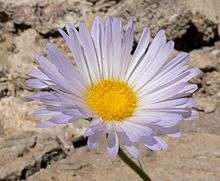Xylorhiza tortifolia
| Xylorhiza tortifolia | |
|---|---|
 | |
| Scientific classification | |
| Kingdom: | Plantae |
| (unranked): | Angiosperms |
| (unranked): | Eudicots |
| (unranked): | Asterids |
| Order: | Asterales |
| Family: | Asteraceae |
| Tribe: | Astereae |
| Genus: | Xylorhiza |
| Species: | X. tortifolia |
| Binomial name | |
| Xylorhiza tortifolia | |
| Synonyms | |
|
Aster orcuttii | |
Xylorhiza tortifolia is a species of flowering plant in the aster family, known by the common names Mojave-aster and Mojave woodyaster.[1]
Distribution
The flowering plant is native to the Mojave Desert, Sonoran Desert, and Great Basin Desert ecoregions of the southwestern United States, California, and northwestern Mexico.[2]
It grows in arid canyons and bajadas/washes, from 240–2,000 metres (790–6,560 ft) in elevation. Habitats it is found in include creosote bush scrub, saltbush scrub, and Joshua tree woodlands.[1]
Description
Xylorhiza tortifolia is a perennial herb or subshrub with branching, hairy, glandular stems that reach 60–80 centimetres (24–31 in) in height/length. The leaves are linear, lance-shaped, or oval, with pointed or spiny tips and spiny edges. The leaf surfaces are hairy and glandular.
The inflorescence is a solitary flower head borne on a long peduncle. The head has a base with long, narrow phyllaries which may be over 2 centimeters long. The head contains up to 60 or more lavender, pale blue, or white ray florets which may be over 3 centimeters long. The bloom period is March through June.[1]
The fruit is an achene which may be over a centimeter long, including its pappus of bristles.
Varieties
- Xylorhiza tortifolia var. imberbis — Imberis woodyaster, Great Basin region in Nevada, Utah, Arizona.[3]
- Xylorhiza tortifolia var. parashantensis — Parashant woodyaster, endemic to Arizona.[4]
- Xylorhiza tortifolia var. tortifolia — Mojave aster, Mojave woodyaster, a variety primarily native to the higher/winter colder Mojave Desert, and Owens Valley of the Great Basin region, from 240–2,000 metres (790–6,560 ft) in elevation.[5][6]
Taxonomy
Desert species of this aster with a woody base (Xylorhiza means woody base) are classified under the genus Xylorhiza, and have been removed from the large and complex genus Machaeranthera, where they were placed for many decades.[7] A similar species, Xylorhiza wrightii−Big Bend aster, is native to the Chihuahuan Desert in western Texas and northern Mexico.[7]
Uses
The Havasupai used the plant for incense and fragrance, with ground leaves carried in the clothes and used as perfume by men and women to counteract body odors.[8]
References
- 1 2 3 Calflora: Xylorhiza tortifolia
- ↑ Flora of North America − Xylorhiza tortifolia
- ↑ USDA: Xylorhiza tortifolia var. imberbis
- ↑ USDA: Xylorhiza tortifolia var. parashantensis
- ↑ Calflora: Xylorhiza tortifolia var. tortifolia
- ↑ Jepson eFlora: Xylorhiza tortifolia var. tortifolia
- 1 2 Lady Bird Johnson Wildflower Center Native Plant Information Network−NPIN: Xylorhiza cognata (Mojave aster, Mojave woodyaster)
- ↑ Native American Ethnobotany Database: Xylorhiza tortifolia var. tortifolia
External links
- Calflora Database: Xylorhiza tortifolia (Mojave woodyaster)
- USDA Plants Profile for Xylorhiza tortifolia (Mojave woodyaster)
- Jepson Manual eFlora (TJM2) treatment of Xylorhiza tortifolia var. tortifolia
- UC Photos gallery for Xylorhiza tortifolia
| Wikimedia Commons has media related to Xylorhiza tortifolia. |